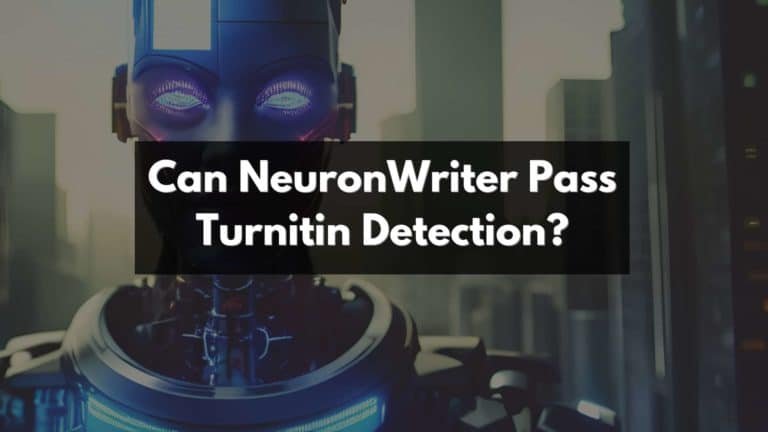Can ParagraphAI Pass Turnitin Detection?
Are you wondering if ParagraphAI, an AI content writer, can dodge the eagle-eyed detection by Turnitin? You’re not alone; I’ve asked myself that same question. In fact, it’s been a hot topic in academic circles recently! Through this article, I will break down how Turnitin’s AI Writing Detection works and explore whether or not Paragraph AI has the potential to bypass this intricate technology.
Keep reading.. This gets interesting!
Key Takeaways
- Turnitin’s AI Writing Detection technology uses parameters such as text analysis, similarity index, and identification of AI-specific phrases to identify AI-generated writing.
- The training process for Turnitin’s model involves feeding it with authentic academic texts and samples of AI-generated content, enabling it to distinguish between human writing and AI-generated text effectively.
- The interpretation of the percentage in the indicator represents the extent of AI – assisted writing detected by Turnitin’s advanced software and does not necessarily indicate plagiarism.
How Turnitin’s AI Writing Detection Works
Turnitin’s AI Writing Detection works by using a set of parameters to identify patterns and characteristics in the text that indicate AI-generated writing.
Parameters for detecting AI writing
I am thrilled to share with you the parameters Turnitin uses to detect AI writing. It’s a meticulous process that involves:
- Text analysis: The software relies heavily on this technique for AI detection.
- Similarity index: Marked increase in this metric raises suspicion of AI involvement.
- Use of AI-specific phrases: Certain phrases and ways of stringing words together can give away an AI writer.
- Frequency of content duplication: High frequency indicates potential use of AI-generated content.
- Identifying patterns typical to certain model outputs, such as GPT-3 or BERT.
- Analysis of writing style inconsistency.
- Detecting unusually perfect grammar and punctuation usage.
Training of Turnitin’s model
Turnitin’s advanced AI detection software is trained using a variety of techniques. It undergoes extensive training to accurately identify AI-assisted writing and content generated by tools like ChatGPT.
The model is fed with large amounts of data, including both authentic academic texts and samples of AI-generated content. Through this training process, the model learns to analyze patterns and distinguish between genuine human writing and AI-generated text.
This training enables Turnitin’s model to detect instances of plagiarism involving AI assistance effectively. Rest assured, Turnitin’s technology is constantly evolving and improving, ensuring that it stays ahead in the battle against plagiarism in academic writing.
Interpretation of AI Writing Detection Results
The interpretation of AI writing detection results includes understanding the meaning of the percentage in the indicator, assessing the accuracy and false positive rate, and recognizing the differences between Similarity score and AI writing detection percentage.
Meaning of the percentage in the indicator
The percentage in the indicator represents the extent of AI-assisted writing detected by Turnitin’s advanced AI detection software. It indicates how much of the content in a submitted document was generated with the help of AI tools or models.
The higher the percentage, the greater the likelihood that AI has been used to write parts of the text. However, it is important to note that a high percentage does not necessarily mean plagiarism; it simply highlights potential AI assistance in creating the document.
Accuracy and false positive rate
Turnitin’s AI writing detection technology boasts a high accuracy rate in identifying AI-generated content. This means that it can successfully flag papers that have been written with the assistance of tools like ChatGPT or ParagraphAI.
However, it is important to note that there may still be false positives – instances where legitimate work is mistakenly flagged as AI-generated. Nevertheless, Turnitin’s advanced AI detection software continues to improve and evolve, ensuring that it remains effective in detecting even the most sophisticated forms of AI-assisted writing.
Differences between Similarity score and AI writing detection percentage
The similarity score and AI writing detection percentage are two different indicators used by Turnitin’s AI detection technology. The similarity score measures the level of content matching between a submitted text and existing sources in Turnitin’s database.
On the other hand, the AI writing detection percentage specifically identifies whether the text has been generated or assisted by AI tools like ChatGPT or Quillbot.
While both indicators serve to identify potential instances of plagiarism, they focus on different aspects. The similarity score highlights textual similarities with existing sources, regardless of whether AI was involved in creating it.
Meanwhile, the AI writing detection percentage directly targets texts that have been written or influenced by artificial intelligence.
It’s important to note that a high similarity score does not necessarily mean that AI was used in generating the text. Similarly, a low or zero similarity score does not guarantee that an AI tool wasn’t involved.
Scope of Turnitin’s AI Writing Detection
Turnitin’s AI Writing Detection not only identifies AI-generated text but also has a scope that includes detecting paraphrased content and future-proofing for advanced versions of AI models.
Models detected by Turnitin’s technology
Turnitin’s advanced AI detection software can identify various models of AI-assisted writing. The software is designed to flag content generated by tools like ChatGPT and Quillbot, which students often use to write their papers. Turnitin’s technology can also detect other AI-generated text, ensuring the integrity of academic writing. However, it is important to note that Turnitin’s detection may not catch all instances of plagiarism involving AI writing.
Future-proofing for advanced versions of AI models
Turnitin’s advanced AI detection software is constantly evolving and improving to keep up with the advancements in AI technology. This means that as AI models become more sophisticated, Turnitin’s software will also adapt to detect them effectively.
So even though ParagraphAI may have the potential to bypass Turnitin detection now, it may not be able to do so in the future as Turnitin continues to future-proof its system against advanced versions of AI models.
Detection of paraphrased AI-generated content
Turnitin’s advanced AI detection software is capable of detecting paraphrased content generated by AI tools. This includes text that has been modified or rephrased using AI algorithms.
Turnitin’s technology analyzes the structure and language of the content to identify similarities with known sources and detect potential instances of plagiarism. While ParagraphAI may attempt to generate text that can pass Turnitin detection, Turnitin’s sophisticated algorithms can still identify such attempts at evasion.
Access and Licensing of Turnitin’s AI Writing Detection Solution
To access and license Turnitin’s AI writing detection solution, individuals or institutions can contact Turnitin directly. The licensing process involves obtaining permission to use the software and agreeing to the terms and conditions set by Turnitin.
It is important to note that this solution is specifically designed for detecting AI-assisted writing and AI-generated content, ensuring academic integrity and preventing plagiarism.
With access to Turnitin’s advanced AI detection software, users can confidently identify any instances of AI-written text and maintain the authenticity of their work.
Conclusion
In conclusion, while ParagraphAI may have the potential to pass Turnitin detection, it is not foolproof and can still be identified by Turnitin’s advanced AI detection software. Students using AI writing tools should be cautious as Turnitin is continually evolving its technology to ensure academic integrity and prevent plagiarism.
Ultimately, relying solely on AI tools to produce original content may jeopardize the authenticity of academic work.
FAQs
1. Can ParagraphAI pass Turnitin detection?
ParagraphAI cannot guarantee that its generated content will pass Turnitin detection as it depends on various factors such as the algorithms used by Turnitin and the similarity of the generated content to existing sources.
2. How does Turnitin detect plagiarism?
Turnitin uses a vast database of academic papers, journals, books, and other sources to compare submitted documents for similarities in text and structure. It identifies potential instances of plagiarism by highlighting matching or similar content within its extensive database.
3. Does using ParagraphAI increase the chances of getting flagged for plagiarism on Turnitin?
Using ParagraphAI may increase the chances of getting flagged for plagiarism on Turnitin if the generated content closely resembles existing sources that are already present in Turnitin’s database. It is important to carefully review and modify any AI-generated content before submitting it to ensure originality.
4. Can I rely solely on ParagraphAI to create original content that won’t be detected by Turnitin?
It is not advisable to solely rely on AI-generated content from ParagraphAI without proper verification and modification when aiming to avoid detection by Turnitin or any other plagiarism-detection software. The best practice is always to use multiple sources, conduct thorough research, and provide proper citations for any referenced material.





